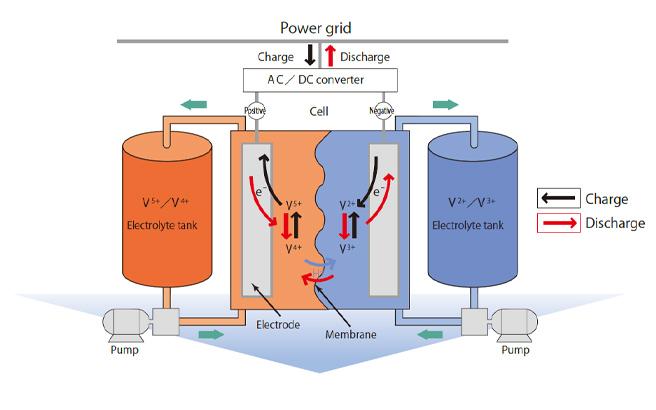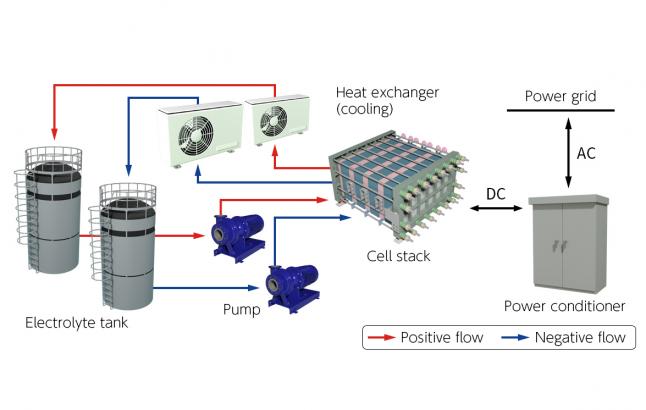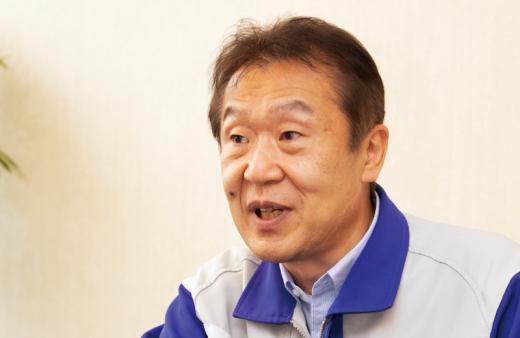
Long-Life and Safe Energy Storage Battery in Pursuit of Usability
Redox flow, collecting knowledge of Sumitomo Electric
Revolutionary large energy storage battery using ionic oxidationreduction reactions
First, we look at the principle and configuration of a redox flow battery. The word redox of a redox flow battery is a combination of reduction and oxidation of active material (material that produces electricity during its chemical change), and the word flow indicates the circulation of an active material solution that is stored in external tanks. As the name suggests, a redox flow battery is a large energy storage battery that circulates an electrolyte by pumps, and charges and discharges electricity by ionic oxidation-reduction reactions. It has a very simple configuration, consisting of basic devices, such as cell stacks (stacked liquid-reflux-type cells), an electrolyte in which an active material is dissolved, and tanks, pumps, and pipes for storing and circulating the electrolyte. Vanadium sulphate aqueous solution is used for the electrolyte. When an electric current passes in a redox flow battery, a battery reaction takes place in accordance with the changes in valence (the number of charges on an ion) of vanadium ions at both the positive and negative electrodes. To adjust the amount of electrons at the positive and negative electrodes, protons move through the membrane that separates both electrodes, resulting in current flows.


Semi-permanently reusable electrolyte
Popular large-capacity batteries include lithium-ion batteries and sodium sulfur (NaS) batteries. In particular, lithium-ion batteries are widely used for consumer products, such as smart phones, personal computers, and electric vehicles. On the other hand, since redox flow batteries are large due to their large tanks and pumps, they have been mainly provided for stationary energy storage systems.
One of the advantages of a redox flow battery is its longer service life than other batteries. Since it uses ionic oxidation-reduction reactions not at electrodes but in the electrolyte to charge and discharge electricity, degradation of the electrodes and electrolyte is very small. The electrolyte can be used semi-permanently. Its design life is more than 20 years. The lifetime does not depend on the number of charging and discharging times, and the number of charging and discharging times has no limit. The second advantage is its higher safety. Since the electrolyte uses noncombustible aqueous solution and facilities consist of flame-retardant materials, combustion risks are extremely low. The third advantage is its higher degree of freedom of design. Since the discharging amp-hour depends on the amount of the electrolyte while the output depends on the number of cell stacks, the output specification and the capacity specification can be designed independently of each other. In addition, since the electrolyte is supplied from the same tank to each cell, the state of charge of each cell is always the same, leading to easy operation. Moreover, since electromotive force of a redox flow battery can be measured even during charging/discharging operations, redox flow batteries are used as countermeasures against unstable output from renewable power plants and are suitable to stabilize grids with complex charging/discharging patterns. Consequently, redox flow batteries allow the optimum design for various needs for storage batteries.
Full-scale market cultivation in 2022
The configuration of a redox flow battery is simple, but it is not easy to ensure the reliability for an extended period of 20 years. Sumitomo Electric has applied our accumulated knowledge, such as the development of 20-year leakage-free cells, a structure design to stack around 100 cells made of thin-walled, large-area flat panels, and functional materials for electrodes, membranes, and bipolar plates that make up cell stacks. We started developing redox flow batteries in 1985, commercialized practical products in 2001, and installed them at consumers’ sites one after another. Consumers have reduced electric charge costs by storing inexpensive power during nighttime and discharging the power during daytime peak hours, and power suppliers have gained the benefits of leveling the electric power load. It was from around 2010, when renewable energy began to be introduced worldwide as a measure against global warming, that the importance of large-capacity storage batteries was emphasized like today.
Storage batteries have an advantage in stabilizing the output fluctuation of renewable energy. The use of storage batteries absorbs the fluctuations and smooths the output. Moreover, it is effective for frequency regulation. In response to supply-demand fluctuations, storage batteries are controlled to instantaneously balance supply and demand and keep the frequency at the standard value.
Rapid and enthusiastic development of redox flow batteries was observed in Europe and China. However, Sumitomo Electric already accumulated knowledge from fieldwork. The redox flow battery business of Sumitomo Electric reached a milestone in 2015, when large-scale demonstration projects started in Hokkaido and California, USA. Currently, these demonstration projects have been completed, and the systems have entered the commercial operation phase. In other words, fullscale market cultivation activities for redox flow batteries have started with thorough preparation.
Sales expansion of redox flow batteries in Japan and abroad
The Energy Systems Division manages the redox flow battery business of Sumitomo Electric. The division aims to “develop and commercialize products and solutions for a new energy market that will expand in accordance with the introduction of renewable energy,” said Takashi Yano, General Manager of the division. Above all, the primary mission is the commercialization of redox flow batteries. What is required for that?

“When storage batteries are evaluated on a conventional scale of kWh, an energy storage battery is simply a cost because it does not generate electric energy. However, in accordance with the introduction of renewable energy, maintaining the balance between power supply and demand on power networks becomes difficult, and the introduction of storage batteries becomes essential. Against this backdrop, the top priority of manufacturers is the reduction of energy storage battery costs. In addition, we must uncover the value of balancing power supply and demand and new usage of storage batteries, as well as actively define our role under the power market and its regulations with stakeholders. In the long run, we must obtain understanding and agreement on the purposes and costs of their introduction from users. Since storage batteries for power grids are infrastructure used for a long time, we can develop not a one-time-fee business model but a service model as a service provider like a PPA (power purchase agreement) service for solar power generation facilities. In fact, the batteries are being provided overseas as an energy storage service. We want to create new usage and value from a box of batteries,” said Yano. What is the marketing strategy envisioned?
“In Japan, we are focusing on electric power providers that have introduced much renewable energy and consumers that are actively introducing renewable energy. The first overseas target is North America, the largest market in the world. We have already completed a demonstration project in California and started commercial operations. Many power companies are interested in batteries that can be used for a long time, and we feel their great expectations for long-life and safe redox flow batteries. In particular, since an electrolyte can be used semi-permanently, not only costs but also environmental burden can be reduced as it is used for a long time. We also provide redox flow batteries while building a local partnership in Australia, which is one of the world’s largest vanadium producers under the concept of local production for local consumption. Australians have high awareness of the environment and are making efforts toward decarbonization, and job creation is also important to them. They fully expect vanadium-related industries to be candidates that will offset the job losses in the declining coal industry in the long run. In Europe, we have also delivered redox flow batteries to a plant in Belgium. We aim to expand sales in European countries. We will reduce costs of redox flow batteries so that they can be used in networks around the world, thus contributing to a decarbonized society,” said Yano.
NEXT
40-Year Enthusiasm for Energy Storage Batteries
– The Struggle to Develop Redox Flow Batteries –
Registration of public notification
If you register your e-mail address, we will notify you when the latest issue is published. If you wish, please register from the registration form.
To delete your registration, please visit here.
